Teaching Strategy and Teaching Method
VerifiedAdded on 2023/06/13
|11
|3143
|279
AI Summary
This paper discusses the learning abilities of two students and suggests specific teaching strategies to enhance their reading development. It also compares mentoring and scaffolding strategies, evaluates the incorporation of ICT, and discusses literacy programs and resources for assessing communication skills.
Contribute Materials
Your contribution can guide someone’s learning journey. Share your
documents today.

Running head: TEACHING STRATEGY AND TEACHING METHOD
TEACHING STRATEGY AND TEACHING METHOD
Name of student:
Name of university:
Author note:
TEACHING STRATEGY AND TEACHING METHOD
Name of student:
Name of university:
Author note:
Secure Best Marks with AI Grader
Need help grading? Try our AI Grader for instant feedback on your assignments.
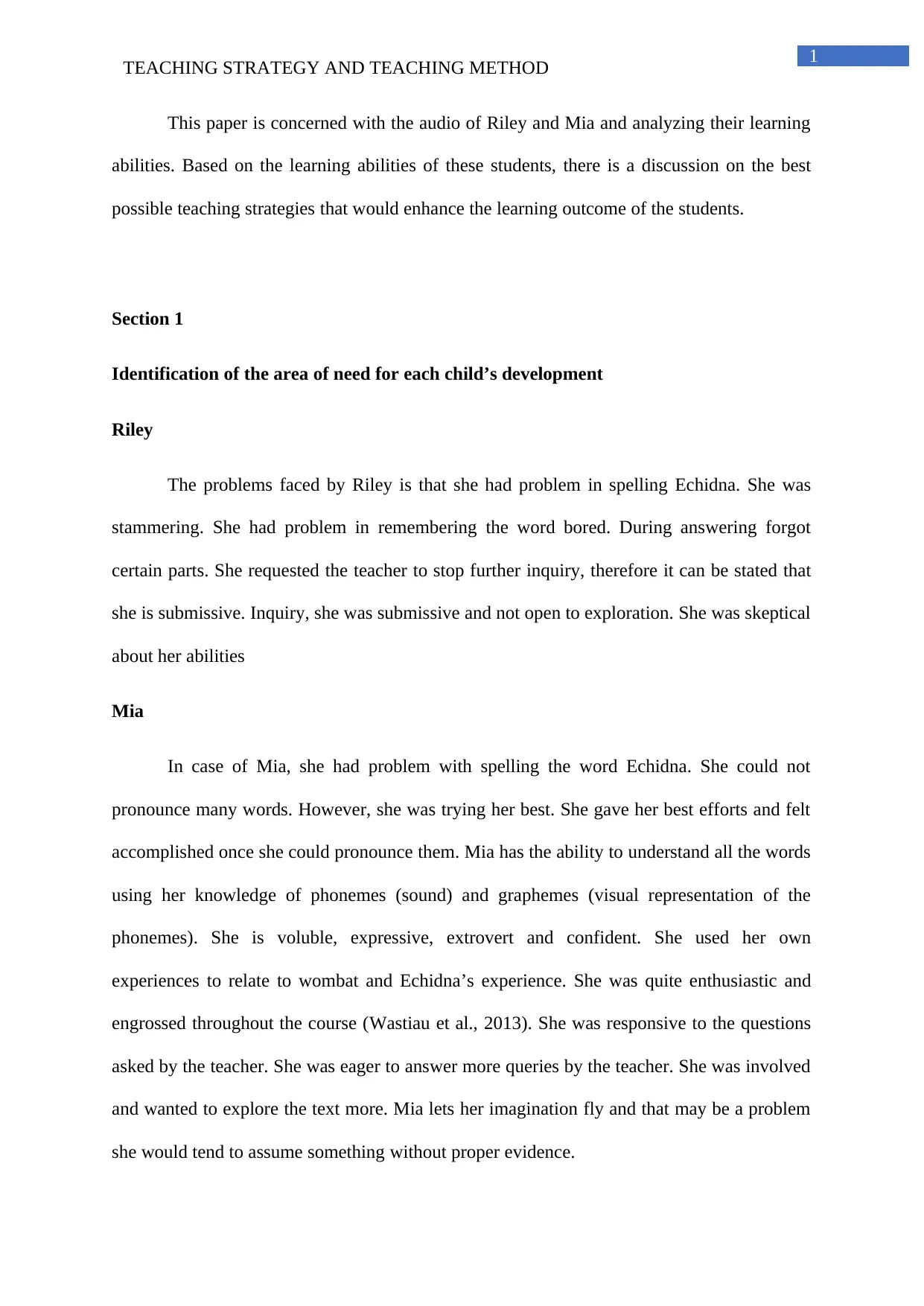
1
TEACHING STRATEGY AND TEACHING METHOD
This paper is concerned with the audio of Riley and Mia and analyzing their learning
abilities. Based on the learning abilities of these students, there is a discussion on the best
possible teaching strategies that would enhance the learning outcome of the students.
Section 1
Identification of the area of need for each child’s development
Riley
The problems faced by Riley is that she had problem in spelling Echidna. She was
stammering. She had problem in remembering the word bored. During answering forgot
certain parts. She requested the teacher to stop further inquiry, therefore it can be stated that
she is submissive. Inquiry, she was submissive and not open to exploration. She was skeptical
about her abilities
Mia
In case of Mia, she had problem with spelling the word Echidna. She could not
pronounce many words. However, she was trying her best. She gave her best efforts and felt
accomplished once she could pronounce them. Mia has the ability to understand all the words
using her knowledge of phonemes (sound) and graphemes (visual representation of the
phonemes). She is voluble, expressive, extrovert and confident. She used her own
experiences to relate to wombat and Echidna’s experience. She was quite enthusiastic and
engrossed throughout the course (Wastiau et al., 2013). She was responsive to the questions
asked by the teacher. She was eager to answer more queries by the teacher. She was involved
and wanted to explore the text more. Mia lets her imagination fly and that may be a problem
she would tend to assume something without proper evidence.
TEACHING STRATEGY AND TEACHING METHOD
This paper is concerned with the audio of Riley and Mia and analyzing their learning
abilities. Based on the learning abilities of these students, there is a discussion on the best
possible teaching strategies that would enhance the learning outcome of the students.
Section 1
Identification of the area of need for each child’s development
Riley
The problems faced by Riley is that she had problem in spelling Echidna. She was
stammering. She had problem in remembering the word bored. During answering forgot
certain parts. She requested the teacher to stop further inquiry, therefore it can be stated that
she is submissive. Inquiry, she was submissive and not open to exploration. She was skeptical
about her abilities
Mia
In case of Mia, she had problem with spelling the word Echidna. She could not
pronounce many words. However, she was trying her best. She gave her best efforts and felt
accomplished once she could pronounce them. Mia has the ability to understand all the words
using her knowledge of phonemes (sound) and graphemes (visual representation of the
phonemes). She is voluble, expressive, extrovert and confident. She used her own
experiences to relate to wombat and Echidna’s experience. She was quite enthusiastic and
engrossed throughout the course (Wastiau et al., 2013). She was responsive to the questions
asked by the teacher. She was eager to answer more queries by the teacher. She was involved
and wanted to explore the text more. Mia lets her imagination fly and that may be a problem
she would tend to assume something without proper evidence.

2
TEACHING STRATEGY AND TEACHING METHOD
Specific teaching strategy will support and extend each child's area of need in reading
development
Riley- Considering the issues of stammering and under confidence reflected in his
reading assignment; Riley is in need of the mentoring approach. It is because, she has
problems decoding certain words and also finds great difficulty in the comprehension of
those words. The goal should be enable Riley help in breaking down the difficult words that
would enable her in understanding the graphemes and phonemes (Meyer, 2015). She needs to
be trained in how sound is coming together. As a teacher, to separately give attention to Riley
and focus on the words Echidna, bored and sunbathing that has found extremely difficult to
pronounce. Shared reading group would be a useful strategy. This would encourage Riley to
consolidate the HFW (High Frequency Words) by locating the focus word. The deployment
of nursery rhymes enables the students to familiarize themselves by understanding the focus
word and a range of other words that would be initially difficult to identify. She needs to
learn the art of mastering the tricky words that would be essential in understanding
graphemes and phonemes.
Mia- Mia was able to pronounce many High Frequency Words (HFW) and she could
easily recognize those words. Mia was showed her efficiency in pronouncing difficult words.
Mia is competent in recognizing difficult words and letters and is able to make meaning out
of them. She is inquisitive and is able to decode the words that is present in the text. In her
case, the scaffolding teaching strategy is the most appropriate. The crux of the scaffolding
technique is that disintegrating the word into chunks and it is followed by providing a
structure or a tool with every chunk (Vanderlinde, Aesaert & Van Braak, 2014). In
scaffolding reading, one gets to preview the text and examine key vocabulary. This feature of
this technique is to provide support to students, in this case Mia and propel the process of
TEACHING STRATEGY AND TEACHING METHOD
Specific teaching strategy will support and extend each child's area of need in reading
development
Riley- Considering the issues of stammering and under confidence reflected in his
reading assignment; Riley is in need of the mentoring approach. It is because, she has
problems decoding certain words and also finds great difficulty in the comprehension of
those words. The goal should be enable Riley help in breaking down the difficult words that
would enable her in understanding the graphemes and phonemes (Meyer, 2015). She needs to
be trained in how sound is coming together. As a teacher, to separately give attention to Riley
and focus on the words Echidna, bored and sunbathing that has found extremely difficult to
pronounce. Shared reading group would be a useful strategy. This would encourage Riley to
consolidate the HFW (High Frequency Words) by locating the focus word. The deployment
of nursery rhymes enables the students to familiarize themselves by understanding the focus
word and a range of other words that would be initially difficult to identify. She needs to
learn the art of mastering the tricky words that would be essential in understanding
graphemes and phonemes.
Mia- Mia was able to pronounce many High Frequency Words (HFW) and she could
easily recognize those words. Mia was showed her efficiency in pronouncing difficult words.
Mia is competent in recognizing difficult words and letters and is able to make meaning out
of them. She is inquisitive and is able to decode the words that is present in the text. In her
case, the scaffolding teaching strategy is the most appropriate. The crux of the scaffolding
technique is that disintegrating the word into chunks and it is followed by providing a
structure or a tool with every chunk (Vanderlinde, Aesaert & Van Braak, 2014). In
scaffolding reading, one gets to preview the text and examine key vocabulary. This feature of
this technique is to provide support to students, in this case Mia and propel the process of
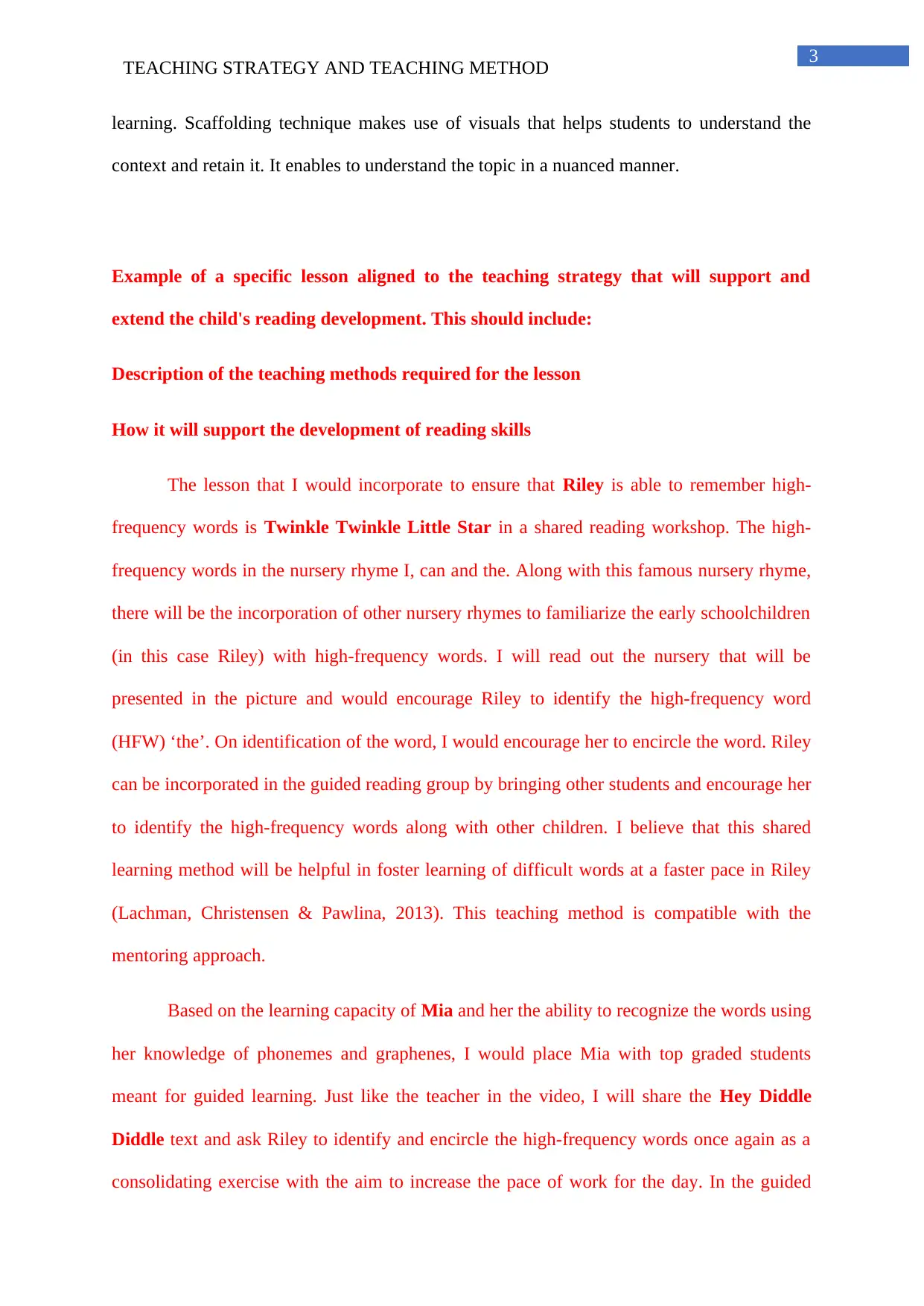
3
TEACHING STRATEGY AND TEACHING METHOD
learning. Scaffolding technique makes use of visuals that helps students to understand the
context and retain it. It enables to understand the topic in a nuanced manner.
Example of a specific lesson aligned to the teaching strategy that will support and
extend the child's reading development. This should include:
Description of the teaching methods required for the lesson
How it will support the development of reading skills
The lesson that I would incorporate to ensure that Riley is able to remember high-
frequency words is Twinkle Twinkle Little Star in a shared reading workshop. The high-
frequency words in the nursery rhyme I, can and the. Along with this famous nursery rhyme,
there will be the incorporation of other nursery rhymes to familiarize the early schoolchildren
(in this case Riley) with high-frequency words. I will read out the nursery that will be
presented in the picture and would encourage Riley to identify the high-frequency word
(HFW) ‘the’. On identification of the word, I would encourage her to encircle the word. Riley
can be incorporated in the guided reading group by bringing other students and encourage her
to identify the high-frequency words along with other children. I believe that this shared
learning method will be helpful in foster learning of difficult words at a faster pace in Riley
(Lachman, Christensen & Pawlina, 2013). This teaching method is compatible with the
mentoring approach.
Based on the learning capacity of Mia and her the ability to recognize the words using
her knowledge of phonemes and graphenes, I would place Mia with top graded students
meant for guided learning. Just like the teacher in the video, I will share the Hey Diddle
Diddle text and ask Riley to identify and encircle the high-frequency words once again as a
consolidating exercise with the aim to increase the pace of work for the day. In the guided
TEACHING STRATEGY AND TEACHING METHOD
learning. Scaffolding technique makes use of visuals that helps students to understand the
context and retain it. It enables to understand the topic in a nuanced manner.
Example of a specific lesson aligned to the teaching strategy that will support and
extend the child's reading development. This should include:
Description of the teaching methods required for the lesson
How it will support the development of reading skills
The lesson that I would incorporate to ensure that Riley is able to remember high-
frequency words is Twinkle Twinkle Little Star in a shared reading workshop. The high-
frequency words in the nursery rhyme I, can and the. Along with this famous nursery rhyme,
there will be the incorporation of other nursery rhymes to familiarize the early schoolchildren
(in this case Riley) with high-frequency words. I will read out the nursery that will be
presented in the picture and would encourage Riley to identify the high-frequency word
(HFW) ‘the’. On identification of the word, I would encourage her to encircle the word. Riley
can be incorporated in the guided reading group by bringing other students and encourage her
to identify the high-frequency words along with other children. I believe that this shared
learning method will be helpful in foster learning of difficult words at a faster pace in Riley
(Lachman, Christensen & Pawlina, 2013). This teaching method is compatible with the
mentoring approach.
Based on the learning capacity of Mia and her the ability to recognize the words using
her knowledge of phonemes and graphenes, I would place Mia with top graded students
meant for guided learning. Just like the teacher in the video, I will share the Hey Diddle
Diddle text and ask Riley to identify and encircle the high-frequency words once again as a
consolidating exercise with the aim to increase the pace of work for the day. In the guided
Secure Best Marks with AI Grader
Need help grading? Try our AI Grader for instant feedback on your assignments.
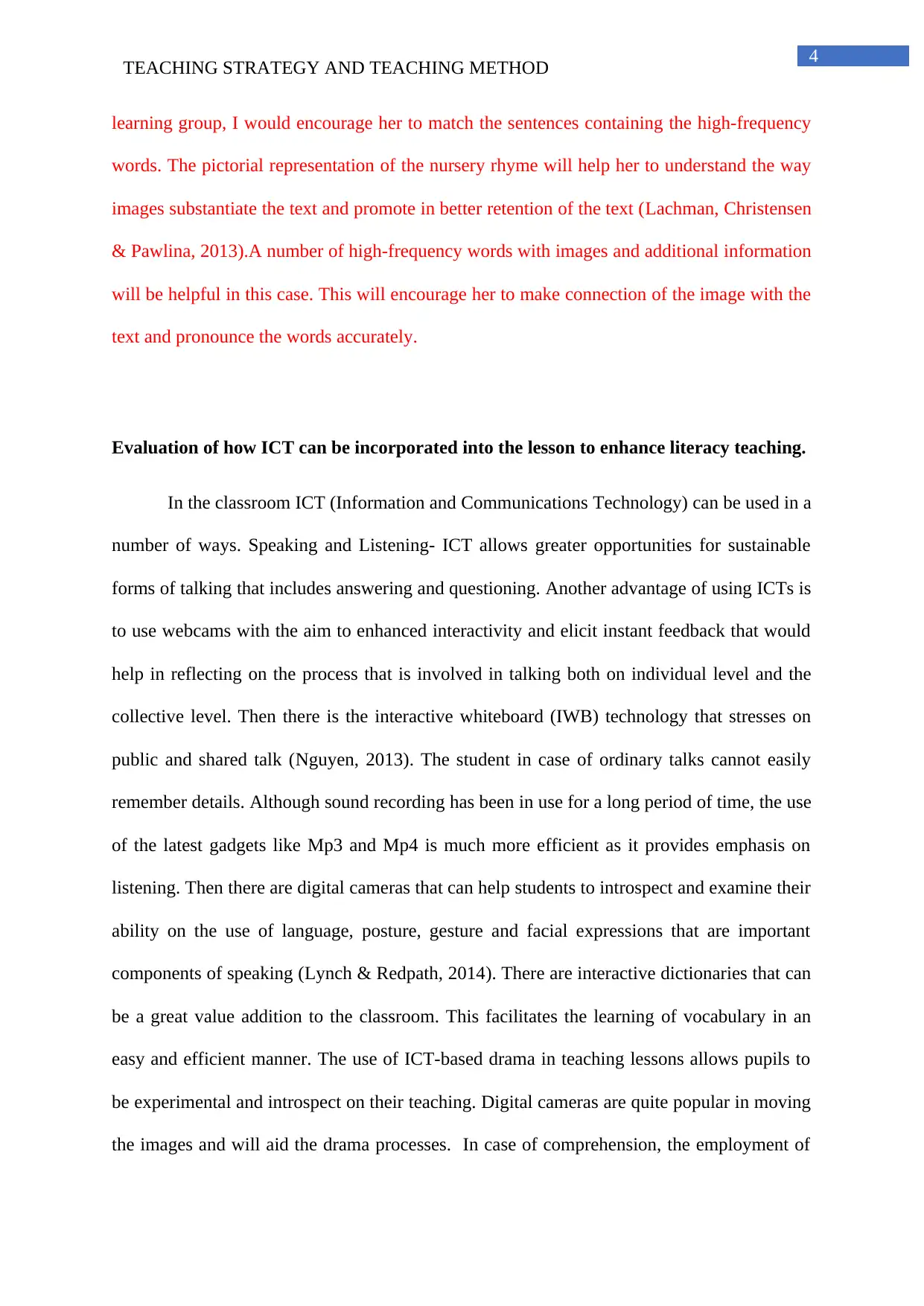
4
TEACHING STRATEGY AND TEACHING METHOD
learning group, I would encourage her to match the sentences containing the high-frequency
words. The pictorial representation of the nursery rhyme will help her to understand the way
images substantiate the text and promote in better retention of the text (Lachman, Christensen
& Pawlina, 2013).A number of high-frequency words with images and additional information
will be helpful in this case. This will encourage her to make connection of the image with the
text and pronounce the words accurately.
Evaluation of how ICT can be incorporated into the lesson to enhance literacy teaching.
In the classroom ICT (Information and Communications Technology) can be used in a
number of ways. Speaking and Listening- ICT allows greater opportunities for sustainable
forms of talking that includes answering and questioning. Another advantage of using ICTs is
to use webcams with the aim to enhanced interactivity and elicit instant feedback that would
help in reflecting on the process that is involved in talking both on individual level and the
collective level. Then there is the interactive whiteboard (IWB) technology that stresses on
public and shared talk (Nguyen, 2013). The student in case of ordinary talks cannot easily
remember details. Although sound recording has been in use for a long period of time, the use
of the latest gadgets like Mp3 and Mp4 is much more efficient as it provides emphasis on
listening. Then there are digital cameras that can help students to introspect and examine their
ability on the use of language, posture, gesture and facial expressions that are important
components of speaking (Lynch & Redpath, 2014). There are interactive dictionaries that can
be a great value addition to the classroom. This facilitates the learning of vocabulary in an
easy and efficient manner. The use of ICT-based drama in teaching lessons allows pupils to
be experimental and introspect on their teaching. Digital cameras are quite popular in moving
the images and will aid the drama processes. In case of comprehension, the employment of
TEACHING STRATEGY AND TEACHING METHOD
learning group, I would encourage her to match the sentences containing the high-frequency
words. The pictorial representation of the nursery rhyme will help her to understand the way
images substantiate the text and promote in better retention of the text (Lachman, Christensen
& Pawlina, 2013).A number of high-frequency words with images and additional information
will be helpful in this case. This will encourage her to make connection of the image with the
text and pronounce the words accurately.
Evaluation of how ICT can be incorporated into the lesson to enhance literacy teaching.
In the classroom ICT (Information and Communications Technology) can be used in a
number of ways. Speaking and Listening- ICT allows greater opportunities for sustainable
forms of talking that includes answering and questioning. Another advantage of using ICTs is
to use webcams with the aim to enhanced interactivity and elicit instant feedback that would
help in reflecting on the process that is involved in talking both on individual level and the
collective level. Then there is the interactive whiteboard (IWB) technology that stresses on
public and shared talk (Nguyen, 2013). The student in case of ordinary talks cannot easily
remember details. Although sound recording has been in use for a long period of time, the use
of the latest gadgets like Mp3 and Mp4 is much more efficient as it provides emphasis on
listening. Then there are digital cameras that can help students to introspect and examine their
ability on the use of language, posture, gesture and facial expressions that are important
components of speaking (Lynch & Redpath, 2014). There are interactive dictionaries that can
be a great value addition to the classroom. This facilitates the learning of vocabulary in an
easy and efficient manner. The use of ICT-based drama in teaching lessons allows pupils to
be experimental and introspect on their teaching. Digital cameras are quite popular in moving
the images and will aid the drama processes. In case of comprehension, the employment of
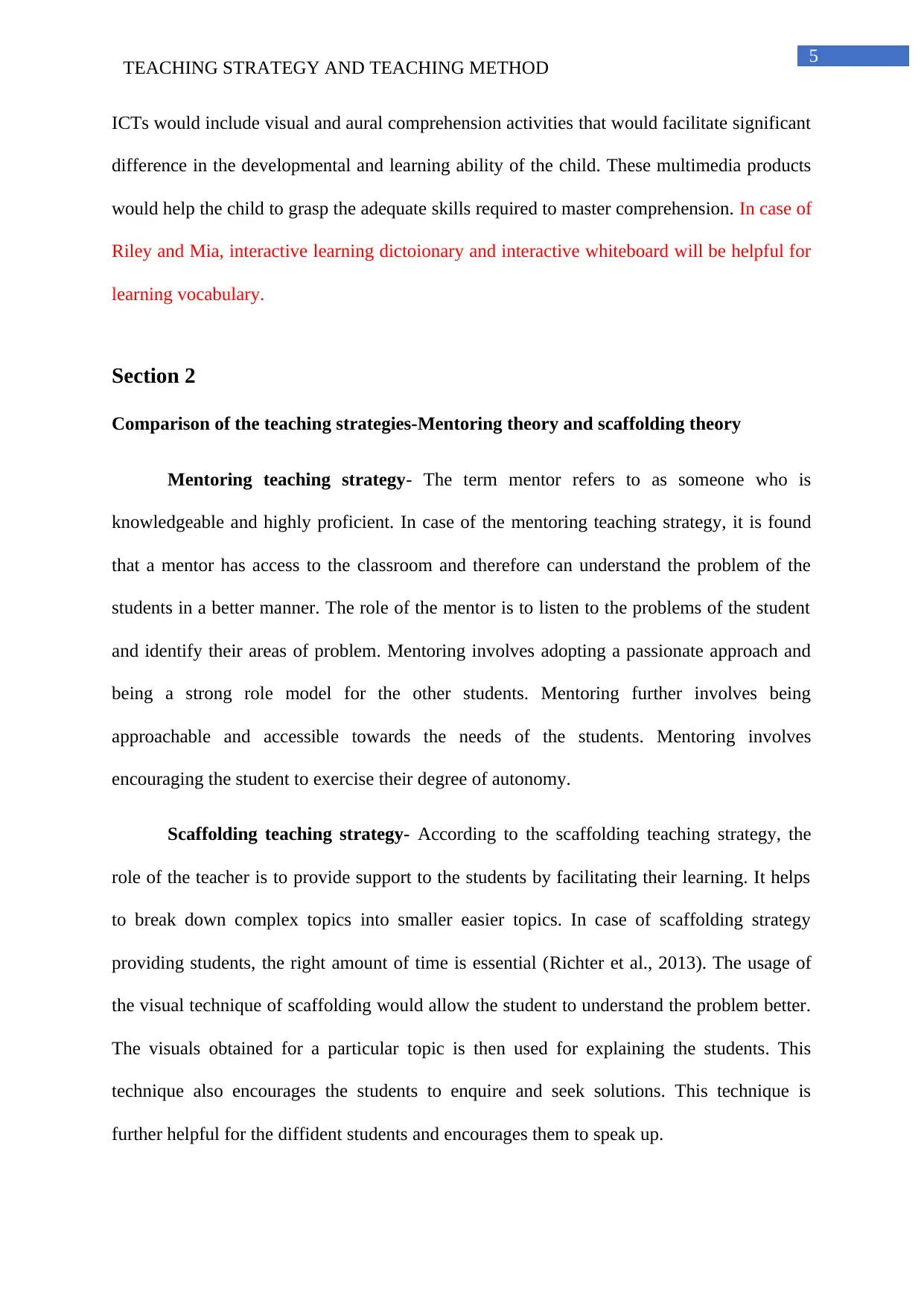
5
TEACHING STRATEGY AND TEACHING METHOD
ICTs would include visual and aural comprehension activities that would facilitate significant
difference in the developmental and learning ability of the child. These multimedia products
would help the child to grasp the adequate skills required to master comprehension. In case of
Riley and Mia, interactive learning dictoionary and interactive whiteboard will be helpful for
learning vocabulary.
Section 2
Comparison of the teaching strategies-Mentoring theory and scaffolding theory
Mentoring teaching strategy- The term mentor refers to as someone who is
knowledgeable and highly proficient. In case of the mentoring teaching strategy, it is found
that a mentor has access to the classroom and therefore can understand the problem of the
students in a better manner. The role of the mentor is to listen to the problems of the student
and identify their areas of problem. Mentoring involves adopting a passionate approach and
being a strong role model for the other students. Mentoring further involves being
approachable and accessible towards the needs of the students. Mentoring involves
encouraging the student to exercise their degree of autonomy.
Scaffolding teaching strategy- According to the scaffolding teaching strategy, the
role of the teacher is to provide support to the students by facilitating their learning. It helps
to break down complex topics into smaller easier topics. In case of scaffolding strategy
providing students, the right amount of time is essential (Richter et al., 2013). The usage of
the visual technique of scaffolding would allow the student to understand the problem better.
The visuals obtained for a particular topic is then used for explaining the students. This
technique also encourages the students to enquire and seek solutions. This technique is
further helpful for the diffident students and encourages them to speak up.
TEACHING STRATEGY AND TEACHING METHOD
ICTs would include visual and aural comprehension activities that would facilitate significant
difference in the developmental and learning ability of the child. These multimedia products
would help the child to grasp the adequate skills required to master comprehension. In case of
Riley and Mia, interactive learning dictoionary and interactive whiteboard will be helpful for
learning vocabulary.
Section 2
Comparison of the teaching strategies-Mentoring theory and scaffolding theory
Mentoring teaching strategy- The term mentor refers to as someone who is
knowledgeable and highly proficient. In case of the mentoring teaching strategy, it is found
that a mentor has access to the classroom and therefore can understand the problem of the
students in a better manner. The role of the mentor is to listen to the problems of the student
and identify their areas of problem. Mentoring involves adopting a passionate approach and
being a strong role model for the other students. Mentoring further involves being
approachable and accessible towards the needs of the students. Mentoring involves
encouraging the student to exercise their degree of autonomy.
Scaffolding teaching strategy- According to the scaffolding teaching strategy, the
role of the teacher is to provide support to the students by facilitating their learning. It helps
to break down complex topics into smaller easier topics. In case of scaffolding strategy
providing students, the right amount of time is essential (Richter et al., 2013). The usage of
the visual technique of scaffolding would allow the student to understand the problem better.
The visuals obtained for a particular topic is then used for explaining the students. This
technique also encourages the students to enquire and seek solutions. This technique is
further helpful for the diffident students and encourages them to speak up.
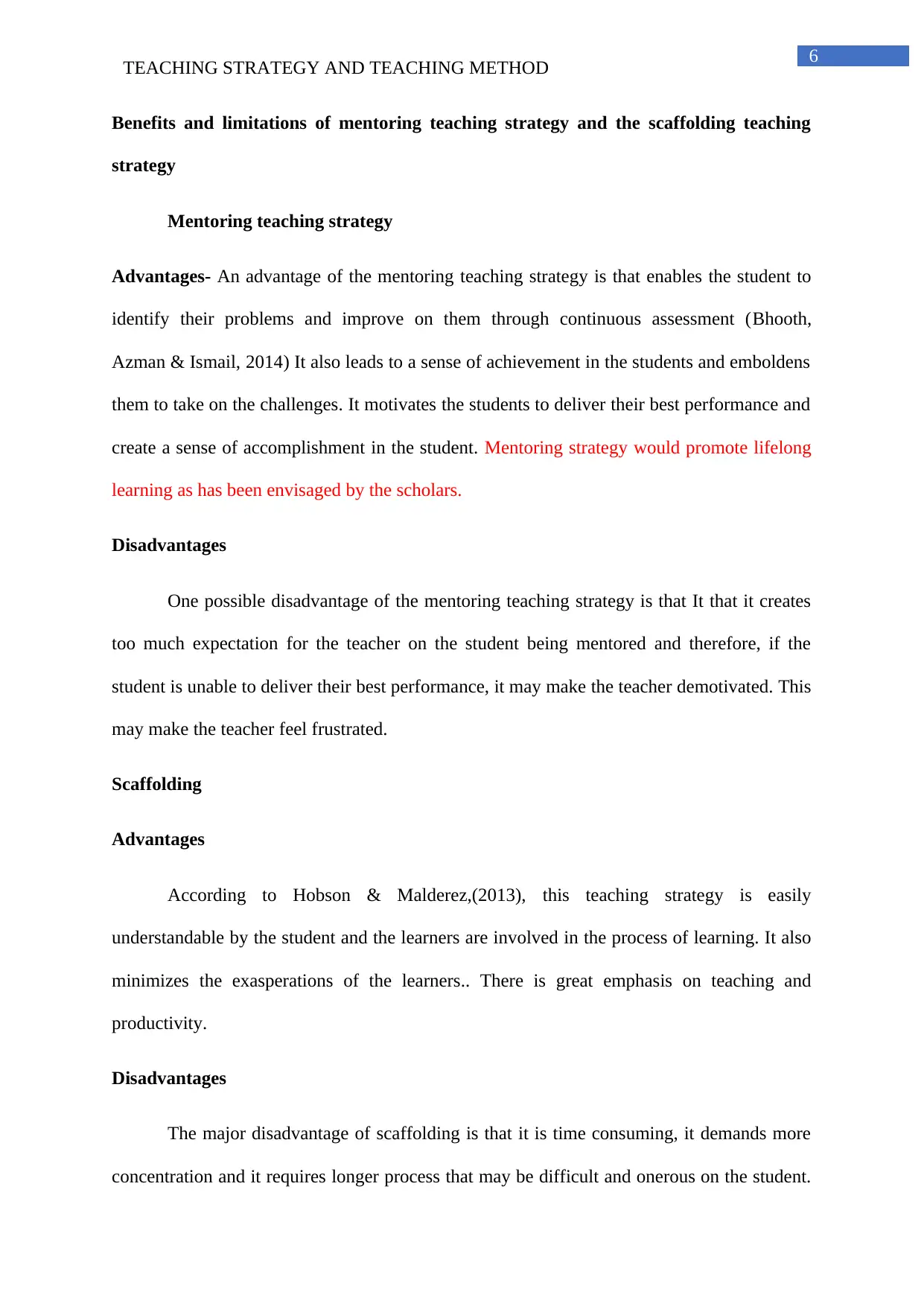
6
TEACHING STRATEGY AND TEACHING METHOD
Benefits and limitations of mentoring teaching strategy and the scaffolding teaching
strategy
Mentoring teaching strategy
Advantages- An advantage of the mentoring teaching strategy is that enables the student to
identify their problems and improve on them through continuous assessment (Bhooth,
Azman & Ismail, 2014) It also leads to a sense of achievement in the students and emboldens
them to take on the challenges. It motivates the students to deliver their best performance and
create a sense of accomplishment in the student. Mentoring strategy would promote lifelong
learning as has been envisaged by the scholars.
Disadvantages
One possible disadvantage of the mentoring teaching strategy is that It that it creates
too much expectation for the teacher on the student being mentored and therefore, if the
student is unable to deliver their best performance, it may make the teacher demotivated. This
may make the teacher feel frustrated.
Scaffolding
Advantages
According to Hobson & Malderez,(2013), this teaching strategy is easily
understandable by the student and the learners are involved in the process of learning. It also
minimizes the exasperations of the learners.. There is great emphasis on teaching and
productivity.
Disadvantages
The major disadvantage of scaffolding is that it is time consuming, it demands more
concentration and it requires longer process that may be difficult and onerous on the student.
TEACHING STRATEGY AND TEACHING METHOD
Benefits and limitations of mentoring teaching strategy and the scaffolding teaching
strategy
Mentoring teaching strategy
Advantages- An advantage of the mentoring teaching strategy is that enables the student to
identify their problems and improve on them through continuous assessment (Bhooth,
Azman & Ismail, 2014) It also leads to a sense of achievement in the students and emboldens
them to take on the challenges. It motivates the students to deliver their best performance and
create a sense of accomplishment in the student. Mentoring strategy would promote lifelong
learning as has been envisaged by the scholars.
Disadvantages
One possible disadvantage of the mentoring teaching strategy is that It that it creates
too much expectation for the teacher on the student being mentored and therefore, if the
student is unable to deliver their best performance, it may make the teacher demotivated. This
may make the teacher feel frustrated.
Scaffolding
Advantages
According to Hobson & Malderez,(2013), this teaching strategy is easily
understandable by the student and the learners are involved in the process of learning. It also
minimizes the exasperations of the learners.. There is great emphasis on teaching and
productivity.
Disadvantages
The major disadvantage of scaffolding is that it is time consuming, it demands more
concentration and it requires longer process that may be difficult and onerous on the student.
Paraphrase This Document
Need a fresh take? Get an instant paraphrase of this document with our AI Paraphraser

7
TEACHING STRATEGY AND TEACHING METHOD
Another less discussed disadvantage of scaffolding is that it makes training in each of the unit
difficult. A scaffolding teacher requires proper training as this teaching strategy requires the
students to make mistakes and a teacher who is not trained would not understand the
significance of such kind of training.
Comparison of literacy programs and resources designed to assess children’s
communication skills, particularly oral language, reading, writing, grammar skills and
phonemic awareness.
There are different literacy programs and resources that are designed to cater to
the learning requirements of students based on their distinctive needs. These literacy
programs are meant at gauging the level of the students and their progress. For example,
aschool in Victoria applies the conferencing method and the use of a running method to
record anecdotal evidence of the children’s literacy needs. This particularly helpful students
belong to diverse linguistic and ethnic backgrounds. The conferencing method is
accomplished by placing all the children in the same table and encouraging them to listen to
one another. Therefore, if one child is discussing, the other children also listens and this is the
highlight of the research. This will enable them to pick up the ideas and the strategies. This
strategy also helps in tracking. Another literacy program that is the ongoing informal
assessment. In this kind of teaching and learning environment, children are encouraged to
flow into each other’s rooms in the building and there is an open environment. Through the
illustration of the butterfly was meant at introducing children to concepts and help them in
remembering those concepts. Through experimental activities, the learning capability of the
children could be gauged- in this case the life cycle of the butterfly. This strategy also helps
in understanding the next steps to be adopted in teaching the child. Every child has a portfolio
and this helps the parens to know about the strength, weakness and the progress of the child.
In this strategy, it is the children who have ownership of the portfolio and they have the
TEACHING STRATEGY AND TEACHING METHOD
Another less discussed disadvantage of scaffolding is that it makes training in each of the unit
difficult. A scaffolding teacher requires proper training as this teaching strategy requires the
students to make mistakes and a teacher who is not trained would not understand the
significance of such kind of training.
Comparison of literacy programs and resources designed to assess children’s
communication skills, particularly oral language, reading, writing, grammar skills and
phonemic awareness.
There are different literacy programs and resources that are designed to cater to
the learning requirements of students based on their distinctive needs. These literacy
programs are meant at gauging the level of the students and their progress. For example,
aschool in Victoria applies the conferencing method and the use of a running method to
record anecdotal evidence of the children’s literacy needs. This particularly helpful students
belong to diverse linguistic and ethnic backgrounds. The conferencing method is
accomplished by placing all the children in the same table and encouraging them to listen to
one another. Therefore, if one child is discussing, the other children also listens and this is the
highlight of the research. This will enable them to pick up the ideas and the strategies. This
strategy also helps in tracking. Another literacy program that is the ongoing informal
assessment. In this kind of teaching and learning environment, children are encouraged to
flow into each other’s rooms in the building and there is an open environment. Through the
illustration of the butterfly was meant at introducing children to concepts and help them in
remembering those concepts. Through experimental activities, the learning capability of the
children could be gauged- in this case the life cycle of the butterfly. This strategy also helps
in understanding the next steps to be adopted in teaching the child. Every child has a portfolio
and this helps the parens to know about the strength, weakness and the progress of the child.
In this strategy, it is the children who have ownership of the portfolio and they have the

8
TEACHING STRATEGY AND TEACHING METHOD
autonomy to decide what they would like to be added. In this strategy, feedback is collected
about the students though the collection of data. This data collection can be in many forms
like observation followed by note taking or simply jotting down the points or use photographs
that would trigger the memory of both the teacher and the children. The voice of the children
is documented and that is used as a briefing session. This is redolent of the Regio Emilio
method of early childhood teaching. The individual needs of the children are discussed with
the team of teachers to foster those skills in the children. This feedback is given back to the
the immediate educators of the children so that it could be used as an assessment tool. The
next method of assessing student literacy is through the the analysis of data to improve the
learning abilities of students. Here, the strategy is for the teachers to teach who to read the
data of the students and then, use that data to improve the learning outcome of children. The
idea si to identify the strength and weaknesses of the students and then formulate a goal that
can be implemented in the classroom. Through the classroom learning and collection of the
data of each students, the teachers able to evaluate the students.
Conclusion
It can be summarized that a teacher needs to adopt teaching strategy based on
the ability of the student and identify the problem areas of the student. There are discussions
on mentoring teaching strategy and scaffolding teaching strategy based on the different
requirements for Mia and Riley.
TEACHING STRATEGY AND TEACHING METHOD
autonomy to decide what they would like to be added. In this strategy, feedback is collected
about the students though the collection of data. This data collection can be in many forms
like observation followed by note taking or simply jotting down the points or use photographs
that would trigger the memory of both the teacher and the children. The voice of the children
is documented and that is used as a briefing session. This is redolent of the Regio Emilio
method of early childhood teaching. The individual needs of the children are discussed with
the team of teachers to foster those skills in the children. This feedback is given back to the
the immediate educators of the children so that it could be used as an assessment tool. The
next method of assessing student literacy is through the the analysis of data to improve the
learning abilities of students. Here, the strategy is for the teachers to teach who to read the
data of the students and then, use that data to improve the learning outcome of children. The
idea si to identify the strength and weaknesses of the students and then formulate a goal that
can be implemented in the classroom. Through the classroom learning and collection of the
data of each students, the teachers able to evaluate the students.
Conclusion
It can be summarized that a teacher needs to adopt teaching strategy based on
the ability of the student and identify the problem areas of the student. There are discussions
on mentoring teaching strategy and scaffolding teaching strategy based on the different
requirements for Mia and Riley.
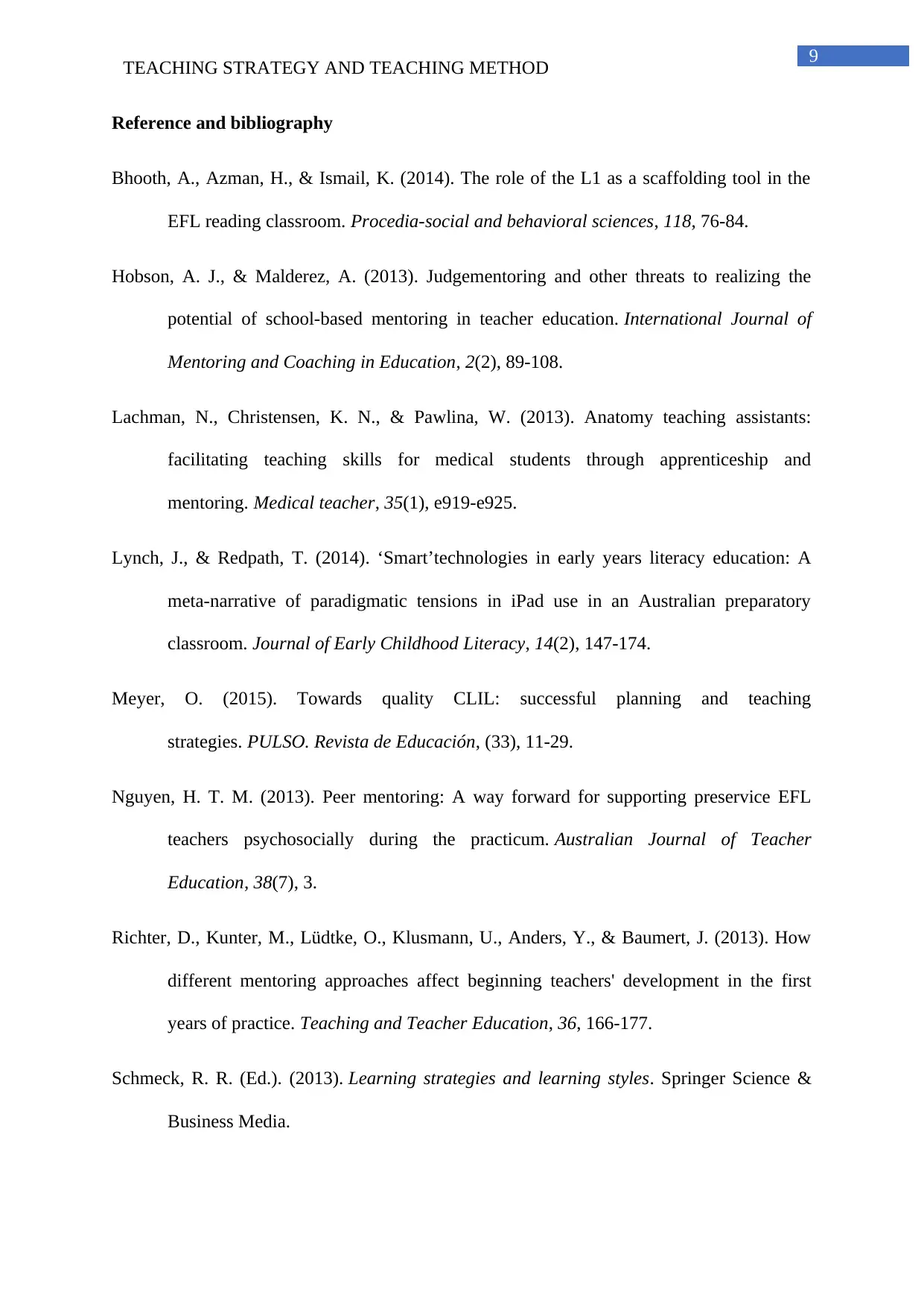
9
TEACHING STRATEGY AND TEACHING METHOD
Reference and bibliography
Bhooth, A., Azman, H., & Ismail, K. (2014). The role of the L1 as a scaffolding tool in the
EFL reading classroom. Procedia-social and behavioral sciences, 118, 76-84.
Hobson, A. J., & Malderez, A. (2013). Judgementoring and other threats to realizing the
potential of school-based mentoring in teacher education. International Journal of
Mentoring and Coaching in Education, 2(2), 89-108.
Lachman, N., Christensen, K. N., & Pawlina, W. (2013). Anatomy teaching assistants:
facilitating teaching skills for medical students through apprenticeship and
mentoring. Medical teacher, 35(1), e919-e925.
Lynch, J., & Redpath, T. (2014). ‘Smart’technologies in early years literacy education: A
meta-narrative of paradigmatic tensions in iPad use in an Australian preparatory
classroom. Journal of Early Childhood Literacy, 14(2), 147-174.
Meyer, O. (2015). Towards quality CLIL: successful planning and teaching
strategies. PULSO. Revista de Educación, (33), 11-29.
Nguyen, H. T. M. (2013). Peer mentoring: A way forward for supporting preservice EFL
teachers psychosocially during the practicum. Australian Journal of Teacher
Education, 38(7), 3.
Richter, D., Kunter, M., Lüdtke, O., Klusmann, U., Anders, Y., & Baumert, J. (2013). How
different mentoring approaches affect beginning teachers' development in the first
years of practice. Teaching and Teacher Education, 36, 166-177.
Schmeck, R. R. (Ed.). (2013). Learning strategies and learning styles. Springer Science &
Business Media.
TEACHING STRATEGY AND TEACHING METHOD
Reference and bibliography
Bhooth, A., Azman, H., & Ismail, K. (2014). The role of the L1 as a scaffolding tool in the
EFL reading classroom. Procedia-social and behavioral sciences, 118, 76-84.
Hobson, A. J., & Malderez, A. (2013). Judgementoring and other threats to realizing the
potential of school-based mentoring in teacher education. International Journal of
Mentoring and Coaching in Education, 2(2), 89-108.
Lachman, N., Christensen, K. N., & Pawlina, W. (2013). Anatomy teaching assistants:
facilitating teaching skills for medical students through apprenticeship and
mentoring. Medical teacher, 35(1), e919-e925.
Lynch, J., & Redpath, T. (2014). ‘Smart’technologies in early years literacy education: A
meta-narrative of paradigmatic tensions in iPad use in an Australian preparatory
classroom. Journal of Early Childhood Literacy, 14(2), 147-174.
Meyer, O. (2015). Towards quality CLIL: successful planning and teaching
strategies. PULSO. Revista de Educación, (33), 11-29.
Nguyen, H. T. M. (2013). Peer mentoring: A way forward for supporting preservice EFL
teachers psychosocially during the practicum. Australian Journal of Teacher
Education, 38(7), 3.
Richter, D., Kunter, M., Lüdtke, O., Klusmann, U., Anders, Y., & Baumert, J. (2013). How
different mentoring approaches affect beginning teachers' development in the first
years of practice. Teaching and Teacher Education, 36, 166-177.
Schmeck, R. R. (Ed.). (2013). Learning strategies and learning styles. Springer Science &
Business Media.
Secure Best Marks with AI Grader
Need help grading? Try our AI Grader for instant feedback on your assignments.
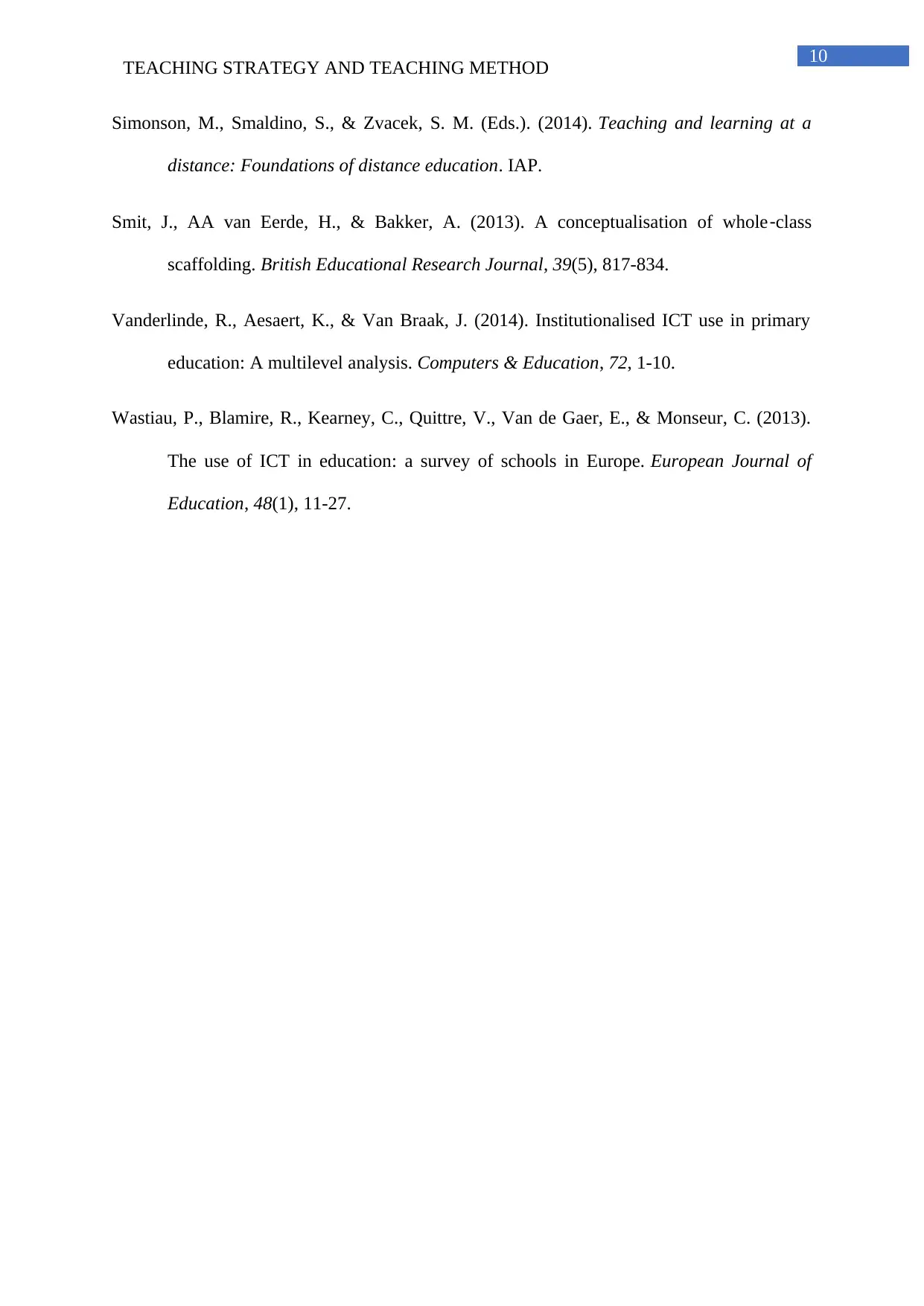
10
TEACHING STRATEGY AND TEACHING METHOD
Simonson, M., Smaldino, S., & Zvacek, S. M. (Eds.). (2014). Teaching and learning at a
distance: Foundations of distance education. IAP.
Smit, J., AA van Eerde, H., & Bakker, A. (2013). A conceptualisation of whole‐class
scaffolding. British Educational Research Journal, 39(5), 817-834.
Vanderlinde, R., Aesaert, K., & Van Braak, J. (2014). Institutionalised ICT use in primary
education: A multilevel analysis. Computers & Education, 72, 1-10.
Wastiau, P., Blamire, R., Kearney, C., Quittre, V., Van de Gaer, E., & Monseur, C. (2013).
The use of ICT in education: a survey of schools in Europe. European Journal of
Education, 48(1), 11-27.
TEACHING STRATEGY AND TEACHING METHOD
Simonson, M., Smaldino, S., & Zvacek, S. M. (Eds.). (2014). Teaching and learning at a
distance: Foundations of distance education. IAP.
Smit, J., AA van Eerde, H., & Bakker, A. (2013). A conceptualisation of whole‐class
scaffolding. British Educational Research Journal, 39(5), 817-834.
Vanderlinde, R., Aesaert, K., & Van Braak, J. (2014). Institutionalised ICT use in primary
education: A multilevel analysis. Computers & Education, 72, 1-10.
Wastiau, P., Blamire, R., Kearney, C., Quittre, V., Van de Gaer, E., & Monseur, C. (2013).
The use of ICT in education: a survey of schools in Europe. European Journal of
Education, 48(1), 11-27.
1 out of 11
Your All-in-One AI-Powered Toolkit for Academic Success.
+13062052269
info@desklib.com
Available 24*7 on WhatsApp / Email
![[object Object]](/_next/static/media/star-bottom.7253800d.svg)
Unlock your academic potential
© 2024 | Zucol Services PVT LTD | All rights reserved.


